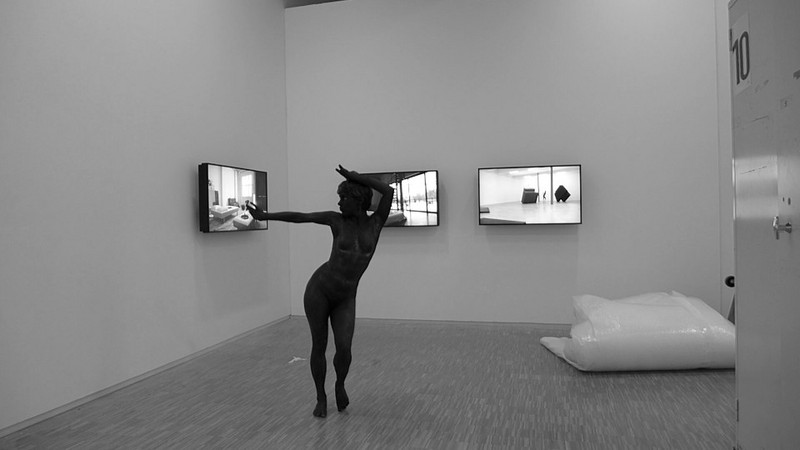Lili Reynaud-Dewar
26 Jun - 19 Sep 2015
LILI REYNAUD-DEWAR
My Epidemic (a body as public as a book can be)
26 June - 19 September 2015
Recently, I started intersecting these abstract dance bits with elements of my life in the studio (or the study) - making things, taking phone calls, looking at myself in the mirror, cleaning up the space, smoking, reading, sitting at my desk, naked and my entire body covered with dark make-up. The videos form some kind of journal, recording the places where I travel, work, exhibit and live. Because I would also like to bear some remote resemblance with myself.
By being repeated and adapted to various contexts, this dance, together with its video renderings themselves (i-e: the products) had gone through various processes of degradation. A transformation occurs, not neccesarily under productive or generative terms, but rather along a trajectory of blurring, loss, distortion and finally exhaustion of both quality and message. The original intention of the work is washed out.
Virginia Woolf spoke about the necessity for an artist to have A Room of One’s Own, but what if being an artist today means having many rooms of many owns? This idea of the private, mental space might be somehow washed out, too. Is there really a thing such as a private space today? And, speaking about being an artist, what do we do with the circulation of our artworks from one space to the other, from this capacity we have gained to adapt and to conform to a huge variety of formats, from this sometimes passive phenomenon that we encounter on seeing our works displayed on screens in such ways that we might not even recognise them?
Talk about your life
My Epidemic (a body as public as a book can be)
26 June - 19 September 2015
Recently, I started intersecting these abstract dance bits with elements of my life in the studio (or the study) - making things, taking phone calls, looking at myself in the mirror, cleaning up the space, smoking, reading, sitting at my desk, naked and my entire body covered with dark make-up. The videos form some kind of journal, recording the places where I travel, work, exhibit and live. Because I would also like to bear some remote resemblance with myself.
By being repeated and adapted to various contexts, this dance, together with its video renderings themselves (i-e: the products) had gone through various processes of degradation. A transformation occurs, not neccesarily under productive or generative terms, but rather along a trajectory of blurring, loss, distortion and finally exhaustion of both quality and message. The original intention of the work is washed out.
Virginia Woolf spoke about the necessity for an artist to have A Room of One’s Own, but what if being an artist today means having many rooms of many owns? This idea of the private, mental space might be somehow washed out, too. Is there really a thing such as a private space today? And, speaking about being an artist, what do we do with the circulation of our artworks from one space to the other, from this capacity we have gained to adapt and to conform to a huge variety of formats, from this sometimes passive phenomenon that we encounter on seeing our works displayed on screens in such ways that we might not even recognise them?
Talk about your life

